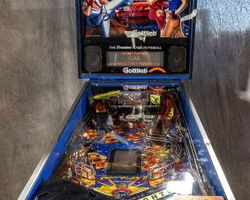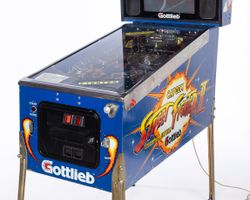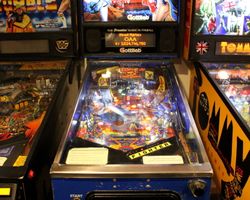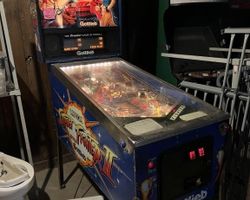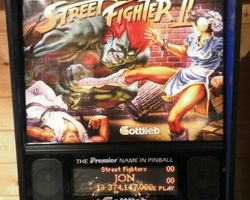Street Fighter II
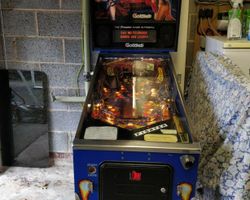
Average Prices: USD $400 to $1,400
Produced: March, 1993
Production Run: 5,550 units
Machine Type: Solid State Electronic
MPU: Gottlieb System 3
Players: 4
Design by: Ray Tanzer, Jon Norris, Bill Parker, Mike Vettros
Art by: Constantino Mitchell, David Moore
Pinball machines often draw inspiration from other forms of entertainment, and in March 1993, D. Gottlieb & Co., operating under the Premier Technology banner, released "Street Fighter II." This machine directly adapted the immensely popular 1991 Capcom arcade video game of the same name, a title that fundamentally shaped the fighting game genre. Unlike a later live-action movie adaptation, this pinball machine immersed players in the pixelated world of the original arcade hit. With a production run of 5,550 units, "Street Fighter II" entered a competitive pinball landscape, aiming to capitalize on a globally recognized intellectual property.
The development of "Street Fighter II" involved a team of experienced pinball designers and artists. Bill Parker, Jon Norris, Mike Vettros, and Ray Tanzer contributed to the machine's design, translating the fast-paced combat of the video game into pinball mechanics. The visual representation was handled by Constantino Mitchell, David Moore, and Jeanine Mitchell, who crafted the playfield and cabinet artwork. Rand Paulin was responsible for the software and animations displayed on the Dot Matrix Display (DMD), while Dave Zabriskie composed the music and Craig Beierwaltes designed the sound effects, meticulously replicating the recognizable audio cues from the arcade game. This collaboration sought to deliver an authentic "Street Fighter II" experience in a new format, a strategy highlighted by Gottlieb’s marketing slogan at the time: "No Location is Complete WITH-OUT this Pair! (SFII Vid & SFII Pin)".
Signature Features and Design
"Street Fighter II" incorporates several distinct elements that define its gameplay experience. A prominent feature is the five-flipper arrangement, which includes a flipper positioned below the main playfield and a unique 360-degree rotating flipper on a multi-level section. While a rotating flipper mechanism had appeared on earlier machines like Stern's 1979 "Hot Hand," its application here added a fresh dynamic to shot opportunities. The machine also boasts three playfield levels, contributing to shot variety and depth. Two main ramps are present, each featuring an elevating entrance mechanism that allows the ball to access targets or mini-playfield sections underneath, adding a layer of strategic decision-making to ramp shots.
The most interactive playfield toy is the "Smashable Car" located in the lower playfield. This physical representation of the iconic bonus stage from the video game allows players to repeatedly strike it, simulating the car-crunching challenge. The Dot Matrix Display, standard for games of this era, works in conjunction with custom speech callouts to provide character animations, score updates, and mode progression information, aiming to replicate the visual and auditory flair of the source material. These features were designed to directly translate key aspects of the video game into a tangible pinball experience, focusing on interactive elements and visual cues that resonate with fans of the franchise.
Playfield and Mechanics
The "Street Fighter II" playfield is a standard width design, rich with targets and shot opportunities that directly tie into the game's objective of defeating opponents. The layout features eight primary shots, each assigned to specific Street Fighter characters, guiding the player through a virtual tournament. These include: sink holes on the lower left for E. Honda and on the lower right for M. Bison & Balrog; a left lane for Blanka; the left ramp targeting Zangief & Sagat; a left sinkhole for Dhalsim; a vertical loopback for Guile; a spiral shot for Ken & Ryu; and the right ramp for Chun Li & Vega.
The design philosophy behind the playfield encourages players to master precise shots to advance. The two main ramps, with their unique elevating entrances, offer not just point-scoring opportunities but also access to hidden targets, enhancing the multi-layered experience. Artwork on the playfield depicts the various characters and scenes from the video game, though its reception regarding artistic quality has been mixed. Lighting is used to indicate active shots and mode progression, guiding the player's focus. The interactive smashable car in the mid-playfield serves as a physical target for the "Car Crunch" mini-game, providing a direct, tactile connection to the video game's bonus stage. The overall aesthetic aims to transport players into the Street Fighter universe, with the layout facilitating a series of targeted shots that mimic the progression of a fighting tournament.
Gameplay Dynamics
The core objective of "Street Fighter II" pinball is to defeat all twelve opponents, mirroring the progression of the arcade game. Players achieve this by hitting the shot associated with the currently lit opponent. Once an opponent is defeated, the game pauses, and players are presented with a choice of rewards, selectable via the flippers. These choices include: immediate points, initiating the "Car Crunch" mini-game, starting multiball, activating "Roaming Ninjas" (randomly lit shots worth increasing points), triggering a "Hurry Up EB" (Extra Ball target lights for a limited time), initiating a "Count-Up" (lower right hole value increases from 3M), a "1-2 Punch" (completing Blanka then Ken & Ryu within a time limit), a "Double Score Round" (hitting four lit shots to double the score), or attempting the "CHAMPION CHALLENGE." This reward system adds a strategic layer to gameplay, allowing players to tailor their immediate objectives based on their current score, ball save status, or desired progression.
The machine features two types of multiball: a two-ball and a three-ball variant. The primary multiball is a progressive jackpot, often triggered by selecting it as a prize or by hitting all barrels on the playfield. During this mode, hitting flashing shots scores jackpots, which increase in value with each successful hit. Achieving the super jackpot resets the multiball to its starting value, encouraging repeat play. A distinct "TORPEDO Multiball" is a three-ball mode initiated by spelling the word "TORPEDO" by hitting specific shots; once active, every switch on the playfield is worth 3 million points, leading to high scoring potential. The ultimate challenge is the "Champion Challenge," which requires players to defeat all twelve opponents a second time on the same ball after their initial conquest. Success in this demanding mode awards 500 million points, a special, and designates the player as the new MASTER, a title held until another player achieves the same feat. This high-risk, high-reward mode provides a significant endgame objective. Additional mechanics include a timed plunger skill shot targeting a "Bracelet" target, an extra ball target lit by hitting three green targets, and a "Second Chance" feature that can return the ball if drained within the first ten seconds of play.
Reception and Legacy
The "Street Fighter II" pinball machine garnered a mixed reception within the pinball community, a reflection of its ambitious attempt to translate a fast-paced fighting video game into a pinball experience. Strengths frequently cited by enthusiasts include the faithful incorporation of the "Street Fighter II" theme. Players appreciate the authentic sound effects and music directly sourced from the video game, which evoke a strong sense of nostalgia. The challenging and engaging gameplay, particularly the nuanced shot selection and the unique ruleset centered around defeating fighters and choosing rewards, appeals to many. Some players find the "stop-and-go" style of gameplay, where action pauses for strategic choices, to be a compelling and distinctive element. Its relative affordability compared to other machines of its era also positions it as an accessible entry point into the hobby, coupled with a reputation for solid build quality and reliability.
However, the machine also faces significant criticism. The artwork, particularly the backglass and some playfield character depictions, is often considered subpar and less appealing than the pixel art of the original video game. The "stop-and-go" gameplay, while appreciated by some, is simultaneously seen as a weakness by others, as it can disrupt the flow and pacing of the game. Repetitive music, callouts, and DMD animations are frequently mentioned as detracting from the long-term experience. The "Car Crunch" mini-game, a beloved element from the video game, is sometimes described as underwhelming in its pinball execution. Additionally, some players find the multiball options limited or the overall ruleset to be unbalanced or overly simplistic, hindering its appeal for deep strategic play.
Despite these polarized views, "Street Fighter II" maintains a presence in the pinball community. Its legacy is complex; it is not universally regarded as a top-tier machine, yet it retains a dedicated following who appreciate its distinct approach to a licensed theme. The machine serves as an interesting case study in adapting a highly popular video game into a pinball format, showcasing both the successes and inherent challenges of such a translation. Its significance lies in its bold attempt to capture the essence of a cultural phenomenon, influencing how future designers would approach integrating complex game mechanics and popular intellectual properties into the physical realm of pinball.
Sponsored Links
 Ebay Listings
Ebay Listings
 Auction Results
Auction Results
| Cost | Location | Date |
|---|---|---|
| GBP £2,950 |  Lytham, United Kingdom Lytham, United Kingdom |
18 November, 2024 |
| USD $2,010 |  Illinois, United States Illinois, United States |
27 September, 2024 |
| GBP £2,950 |  Lytham, United Kingdom Lytham, United Kingdom |
01 September, 2024 |
| GBP £1,555 |  Prudhoe, United Kingdom Prudhoe, United Kingdom |
29 July, 2024 |
| USD $2,200 |  Maryland, United States Maryland, United States |
06 June, 2024 |
| USD $1,900 |  Georgia, United States Georgia, United States |
14 February, 2024 |
| GBP £2,950 |  Lytham, United Kingdom Lytham, United Kingdom |
18 January, 2024 |
| EUR €2,029 |  Niedersachsen, Germany Niedersachsen, Germany |
11 June, 2023 |
| USD $3,300 |  California, United States California, United States |
22 October, 2022 |
| GBP £2,450 |  United Kingdom United Kingdom |
30 May, 2022 |


Private Policy · Search Website · Contact Us
As an eBay Partner, we may earn a commission from qualifying purchases made through links on this site, at no additional cost to you.
All trademarks and copyrighted materials remain property of their respective owners. All other content copyright 2007 - 2025 Pinpedia.

